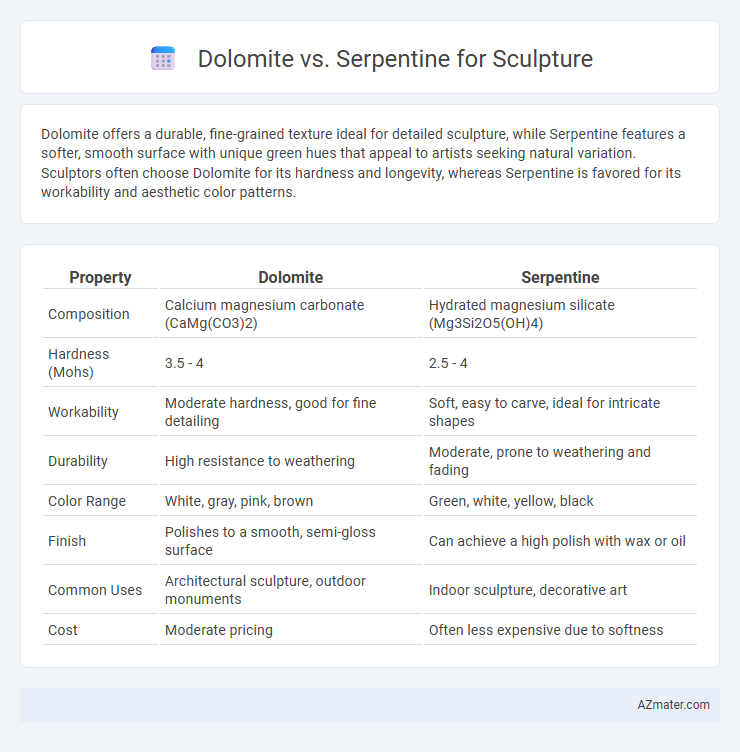Dolomite offers a durable, fine-grained texture ideal for detailed sculpture, while Serpentine features a softer, smooth surface with unique green hues that appeal to artists seeking natural variation. Sculptors often choose Dolomite for its hardness and longevity, whereas Serpentine is favored for its workability and aesthetic color patterns.
Table of Comparison
| Property | Dolomite | Serpentine |
|---|---|---|
| Composition | Calcium magnesium carbonate (CaMg(CO3)2) | Hydrated magnesium silicate (Mg3Si2O5(OH)4) |
| Hardness (Mohs) | 3.5 - 4 | 2.5 - 4 |
| Workability | Moderate hardness, good for fine detailing | Soft, easy to carve, ideal for intricate shapes |
| Durability | High resistance to weathering | Moderate, prone to weathering and fading |
| Color Range | White, gray, pink, brown | Green, white, yellow, black |
| Finish | Polishes to a smooth, semi-gloss surface | Can achieve a high polish with wax or oil |
| Common Uses | Architectural sculpture, outdoor monuments | Indoor sculpture, decorative art |
| Cost | Moderate pricing | Often less expensive due to softness |
Introduction to Dolomite and Serpentine in Sculpture
Dolomite and serpentine are popular choices for sculptors due to their workability and aesthetic qualities. Dolomite, a carbonate mineral composed of calcium magnesium carbonate, offers durability and a fine-grained texture ideal for detailed carvings. Serpentine, known for its rich green hues and smooth texture, provides malleability and a distinctive coloration that enhances artistic expression in sculpture.
Geological Origins and Composition
Dolomite is a sedimentary carbonate rock composed primarily of the mineral dolomite (CaMg(CO3)2), formed through the alteration of limestone by magnesium-rich waters in marine environments. Serpentine consists mainly of serpentine group minerals, resulting from the metamorphic alteration of ultramafic rocks rich in olivine and pyroxene under hydrothermal conditions. The distinct geological origins and mineral compositions influence their textures and workability, with dolomite offering a fine-grained crystalline structure and serpentine presenting a more fibrous or smooth veined appearance ideal for detailed sculpture.
Physical Properties Comparison
Dolomite features a Mohs hardness of 3.5 to 4 and a crystalline structure that allows for fine detail carving, making it moderately durable for sculptures. Serpentine, with a lower hardness of 2.5 to 5.5 and a softer, more flexible texture, offers easier workability but less resistance to weathering. Both stones exhibit distinct crystallography and density variations, influencing their stability and finish in artistic applications.
Workability for Sculptors
Dolomite offers superior workability for sculptors due to its fine-grained texture and moderate hardness, allowing for detailed carving and smooth finishes. Serpentine, while softer and easier to carve initially, tends to have a more variable composition that can lead to uneven surfaces and increased risk of fracturing. Sculptors prefer dolomite for projects requiring precision and durability, whereas serpentine suits more experimental or less detailed sculptures.
Color and Aesthetic Qualities
Dolomite offers a range of subtle cream to gray hues with occasional pink or brown veining, providing a classic and elegant appearance favored for detailed sculptures. Serpentine displays vibrant green tones, often with mottled or veined patterns, delivering a more dynamic and visually striking aesthetic that enhances organic forms. The choice between dolomite and serpentine depends on whether a sculptor prefers muted sophistication or bold, natural coloration to complement their artistic vision.
Durability and Weather Resistance
Dolomite exhibits superior durability and weather resistance compared to serpentine, making it a preferred choice for outdoor sculpture projects exposed to varying climatic conditions. Its crystalline structure enhances resistance to erosion, acid rain, and freeze-thaw cycles, ensuring longevity and minimal surface degradation. In contrast, serpentine's softer composition and susceptibility to chemical weathering limit its use in environments with harsh weather exposure.
Finishing Techniques and Surface Texture
Dolomite offers a fine-grained, consistent texture ideal for detailed finishing techniques such as polishing and fine carving, resulting in a smooth, glossy surface that enhances intricate design elements. Serpentine's naturally waxy, softer texture lends itself to varied finishing methods, including natural polishing and chemical treatments, creating a tactile surface with a subtle sheen that emphasizes its rich, variegated colors. Both stones respond well to abrasive and hand-finishing tools, but dolomite's hardness supports sharper detail work while serpentine allows for more organic, softer contours in sculpture.
Cost and Availability
Dolomite is generally more affordable and widely available for sculpture due to its abundant deposits and easier extraction processes, making it a cost-effective choice for artists and sculptors. Serpentine, while valued for its attractive coloration and distinctive patterns, tends to be more expensive and less accessible, often sourced from limited geographical regions. The pricing gap and supply constraints mean Dolomite is preferred for large-scale or budget-conscious projects, whereas Serpentine is favored for high-end, detailed work.
Notable Sculptures and Artists
Dolomite, prized for its fine-grain texture and durability, has been favored by renowned sculptors like Michelangelo, whose use of this marble variant is evident in the intricate details of his statues. Serpentine, while softer and easier to carve, has been prominently utilized by sculptors such as Barbara Hepworth, who exploited its unique green hues and smooth finish to create modernist forms. Notable sculptures like the Dolomite "Madonna of Bruges" and Hepworth's serpentine abstract works highlight the distinct aesthetic qualities each stone brings to the art of sculpture.
Choosing the Right Stone for Your Sculpture
Dolomite offers durability and a fine grain ideal for detailed sculptures, making it suitable for artists seeking a smooth finish and resistance to weathering. Serpentine provides a softer texture that allows for easier carving and a unique, rich coloration, preferred for intricate designs and indoor sculptures. Selecting between Dolomite and Serpentine hinges on factors like desired hardness, weather resistance, and the specific aesthetic qualities needed for the sculpture.

Infographic: Dolomite vs Serpentine for Sculpture
 azmater.com
azmater.com